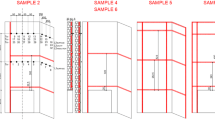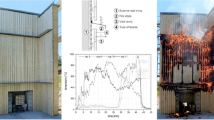Abstract
With regard to fire safety for exterior walls of a building, fire-resistance performance is considered, according to the current building standard law of Japan. And it was revealed that the fire safety is not specifically regulated from the viewpoint of reaction-to-fire performance, such as fire propagation caused by combustible materials or products which are installed on the exterior side of fire-resistant load-bearing walls. Actual fire issues in the world have shown that massive façade fire could occur at the exterior side of building wall even when the wall itself is fire-resistant. In previous studies of the authors, a test method of façade fire was tentatively proposed for evaluating the vertical fire propagation over an external wall within the same building. Furthermore, especially at the high-density residential areas in Japan, fire spreading would occur mostly from window to window between adjacent buildings, while walls are not burning by façade fire. But in case of combustible façades, such as insulating materials, combustible coating, or even sandwich panel are installed on the wall surface, once they are ignited, façade fire would occur and accelerate both the fire propagation in the same building and the fire spreading to the adjacent building. In this paper, results of fire tests on combustible façades are discussed from the viewpoints of both vertical fire spread along façades and fire spread between adjacent buildings assuming the densely populated residential area in Japan. The tentative criteria were determined based on the time to reach 500°C and duration time exceeding 500°C on façade surface for vertical fire spread along façade. As for intensively burned cases, at 2500 mm height from upper edge of the opening, specimens of exterior thermal insulation system with 200-mm thick expanded polystyrene (EPS), aluminum composite panel with polyethylene core and wooden façade without fire-retardant treatment continued exceeding 500°C for 3.1 min, 5.7 min, and 3.6 min, respectively, that were longer duration compared with specimens of resin painting (approximately 1 min). On the other hand, the another tentative criteria were determined for horizontal fire spread to an adjacent building based on the duration time exceeding the calibration test’s peak incident heat flux on opposite surface 2000 mm from façade surface for horizontal fire spread to an adjacent building. At 500 mm height from upper edge of the opening, specimens of exterior thermal insulation system with high-density 100-mm thick EPS and wooden façade without fire-retardant treatment continued exceeding the peak incident heat flux of calibration test for 13.1 min and 13.6 min, respectively, while one specimen of resin painting and aluminum composite panel with polyethylene core continued for shorter duration of 4.2 min and 5.8 min, respectively, even though they showed relatively high peak façade surface temperatures.



























Similar content being viewed by others
References
Duval B (2008) Monte Carlo Hotel Casino Fire. NFPA J 102(3):67–70
ISO 13785-1 & 2:2002, Reaction-to-fire tests for façades-Part 1: intermediate-scale test and Part 2: Large-scale test
Hsin-Chieh Yang, Hideki Yoshioka et al (2009) Basic research of fire properties exterior insulation and finish systems, Part 3: reaction-to-fire tests for façades, Intermediate-scale test. Summaries of Technical Papers of Annual Meeting, Architectural Institute of Japan, pp. 333–334 (in Japanese)
Yoshioka H, Ohmiya Y, Noaki M, Yoshida M (2011) Large-scale Façade Fire Tests Conducted Based on ISO 13785-2 with Noncombustible Façade Specimens. Fire Sci Technol 31(1):1–22
BS 8414-2 (2005) Fire performance of external cladding systems-Part 2: test method for non-loadbearing external cladding systems fixed to and supported by a structural steel frame
SP FIRE 105 Method for fire testing of facade materials, Dnr. 171-79-360 Department of Fire Technology, Swedish National Testing and Research Institute
NFPA 285. Standard fire test method for evaluation of fire propagation characteristics of exterior non-loadbearing wall assemblies containing combustible components 2006 Edition
CAN/ULC-S134. Standard method of fire test of exterior wall assemblies. Underwriters Laboratories of Canada, 2013
Babrasukas V (1996) Façade fire tests: towards an international test standard. Fire Technol 32:219–230. doi:10.1007/BF01040215
Oleszkiewicz I (1990) Fire exposure to exterior walls and flame spread on combustible cladding. Fire Technol 26:357–375. doi:10.1007/BF01293079
Wade CA, Clampett JC (2000) Fire Performance of Exterior Claddings, BRANZ REPORT
Hakkarainen T, Oksanen T (2002) Fire safety assessment of wooden facades. Fire Mater 26(1):7–27
Abecassis E (2010) Analysis of the compartment fire parameters influencing the heat flux incident on the structural façade. Ph.D. Dissertation, Univ. Edinburgh, Scotland
White N, Delichatsios M, Ahrens M, Kimball A (2005) Fire hazards of exterior wall assemblies containing combustible components. In: Proceedings of 1st international seminar for fire safety of facades, CSTB. MATEC web of conferences 9, 02005. http://dx.doi.org/10.1051/matecconf/20130902005
Smolka M, Messerschmidt B, Scott J, le Madce B (2012) Semi-natural test methods to evaluate fire safety of wall claddings. In: Proceedings of 1st international seminar for fire safety of facades, CSTB. MATEC web of conferences 9, 02012. http://dx.doi.org/10.1051/matecconf/20130902012
Andersson J, Jansson R (2013) Fire dynamics in façade fire tests: measurement and modelling, Volume: 13 Interflam 2013, Interscience, London
Yoshioka H, Nishio Y, Tamura M, Yoshida M, Noguchi T, Ohmiya Y, Kanematsu M, Ando T, Koura K, Tomatsu T, Ozaki Y (2014) Façade tests on fire propagation along combustible exterior wall systems. Fire Sci Technol 33(1):1–15
JIS A 1310 (2015) Test method for fire propagation over building façades (in Japanese)
Kang Seung Goo, Masaki Noaki, Yoshifumi Ohmiya, Hideki Yoshioka, Takafumi Noguchi, Masatoshi Nakamura, Ko Muraoka, Takeshi Morita, Yoshikazu Deguchi: “A consideration on fire intensity of JIS A 1310: Test method for fire propagation over building facades”, Summaries of Technical Papers of Annual Meeting, Architectural Institute of Japan
Shizuo Yokoi (1959) Spandrel height from the viewpoint of fire safety, Report in Architectural Institute of Japan (in Japanese)
Acknowledgments
Authors would like to acknowledge specimen suppliers, technicians, and students for their contribution to façade fire tests in this paper.
Author information
Authors and Affiliations
Corresponding author
Rights and permissions
About this article
Cite this article
Nishio, Y., Yoshioka, H., Noguchi, T. et al. Fire Spread Caused by Combustible Facades in Japan. Fire Technol 52, 1081–1106 (2016). https://doi.org/10.1007/s10694-015-0535-5
Received:
Accepted:
Published:
Issue Date:
DOI: https://doi.org/10.1007/s10694-015-0535-5




